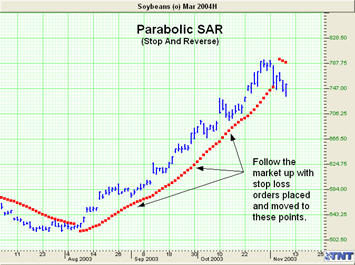Introduction:
The Parabolic SAR, Developed by Welles Wilder, creator of RSI and DMI, sets trailing price stops for either long or short positions. Also referred to as the stop-and-reversal indicator (SAR stands for "stop and reversal"), Parabolic SAR is more popular for setting stops than for establishing direction or trend. Wilder recommended establishing the trend first, and then trading with Parabolic SAR in the direction of the trend. If the trend is up, but the underlying price drops back below the trailing PSAR indicator, then sell or liquidate your long position. If the trend is down, and the underlying price rises above the trailing PSAR indicator then buy or liquidate your short position.
Example of PSAR in Track ‘n Trade:

Calculation:
Parameters:
Initial (20) - the initial acceleration factor, in 1/1000.
Addition (20) - the additional acceleration factor, in 1/1000.
Limit (200) - the acceleration factor limit, in 1/1000.
Formula:
The computational procedure for the parabolic time/price study is a logic exercise. The actual computations are quite simple. The logic to derive those computations is somewhat more complex.
Once the market establishes a direction, the initial SAR becomes the extreme price for the two intervals. The extreme price is either the lowest price or highest price for the two trading intervals. The short position uses the high, and the long position uses the low.
The formula for the PSAR is:
SARt = SARt-1 + ( a * ( EPtrade - SARt-1) )
SARt - The stop and reverse price for the current interval.
SARt-1 is the stop and reverse price for the previous interval.
a -The acceleration factor.
EPtrade - The extreme price for the trade.
The SAR is always the "stop and reverse" price point. This is the point you liquidate your current position and establish the opposite position.
The acceleration factor, a, is a weighting factor. In Wilder's work, the initial value for the acceleration factor is .02 The acceleration factor increases by a value of .02 each time the extreme price changes for the trade. You do not increment the acceleration factor if the extreme price fails to change. The value for a, acceleration factor, never exceeds .20 in Wilder's methodology.
The extreme price for the trade, EP, is just that. What was the highest or lowest price achieved during this trade? If you have a long position, use new highs as the extreme price. When you have a short position, use the new lows as the extreme price. The extreme price concept allows for normal market corrections without immediately triggering the SAR price, but it keeps the SAR price moving in the direction of the market.
Customizing:
To change the settings of this indicator, open the Program Options screen by clicking the Program Options button located on the main Toolbar. See the Program Options section for more details on changing the settings of each indicator.